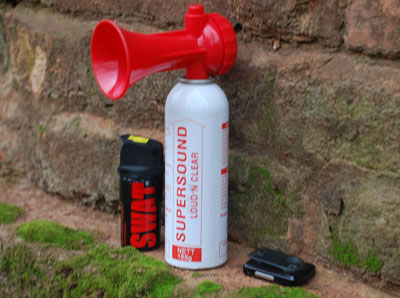
YAMBIO, Southern Sudan — Everyone at the dinner table shied away when a friend here, a longtime aid worker and old Sudan hand, started unloading the contents of a plastic bag: a can of mace, an air horn, a whistle with a bright light, and last but not least, a taser. Then he began demonstrating each tool, sending up a distressing cacophony of shrill whistles, bullhorn blasts, and loud, painful-sounding buzzes.
Here in a place where the brutal Lord’s Resistance Army, or LRA, launch regular incursions, and the streets in town clear out at dark as people voluntarily move to the relative safety of their homes, the sounds were startling, even as we sat in our secure compound around the corner from the United Nations Mission in Sudan.
When the racket stopped, our friend explained himself: this assortment of noisemakers and non-lethal weapons are just what the local communities need to help fend off the LRA.
Skeptical? We were too. But as our friend explained, a village armed with these tools would be ready to undercut one of the LRA’s main tactics: surprise. From the dense forests of Western Equatoria state here in Sudan, as well as in the jungles of northeastern Congo and eastern Central African Republic, the LRA are able to stalk their victims without being seen until just moments before they begin attacking. With our friend’s toolkit at their disposal, a village’s residents might be able to protect themselves once a LRA attack begins. A woman under assault could spray mace in her attacker’s face; a young boy could create a diversion by throwing a high-pitched whistle with a bright light in one direction as he flees in the other; the village chief could alert his community and the surrounding villages of the attack by blowing the air horn; a man could temporarily paralyze an attacker by tasing him.
The concept would also support what seems to currently be the best strategy for responding to the immediate threats of the LRA and protecting civilians. Men and boys from many of the communities in the region have taken up arms to defend their families and are loosely affiliated, calling themselves the Arrow Boys. Even the government has vocally supported them. The Arrow Boys’ advantage is that they can mobilize quickly, sharing information about the LRA’s whereabouts on the few cell phones distributed among their informal ranks. “When we hear about the LRA attacking, we all take our guns and run to the front line,” explained a 23-year old Arrow Boy living in a camp for displaced people outside of Yambio.
One benefit of our friend’s concept is that since the toolkit isn’t lethal, there’s little threat of people reusing the tools in predatory ways. Except, of course, the taser. “The taser would require the would-be victim to be too close to the aggressor, and it is the expensive part anyway,” our friend said. Ok, scrap the taser idea. In total, the air horn, mace, and whistle cost about $30. A village would need just one air horn plus mace and whistles to go around.
Whether the Sudanese people would be open to the concept, or whether our friend will find a donor interested in funding such an unconventional project remains to be seen. But it was great to see someone with years of experience working in the field looking for creative ways to tackle one of the major challenges facing the people here in close range of the LRA. After all, in the absence of an effective government response to protect the civilians targeted by the LRA, why not further empower the people who are actually getting the job done?

